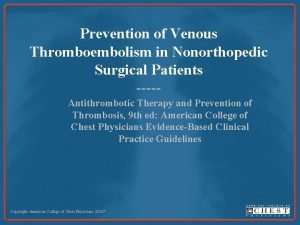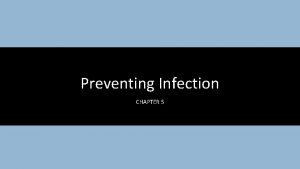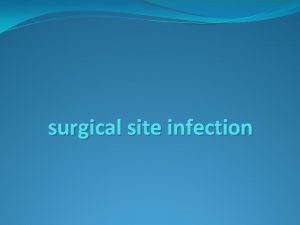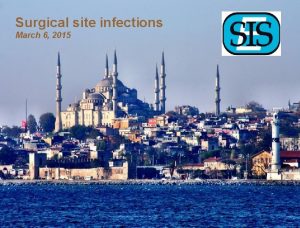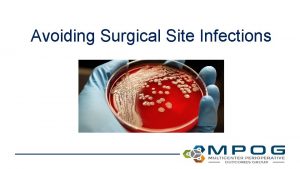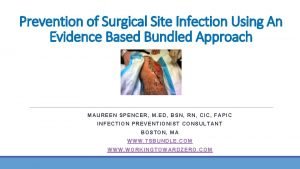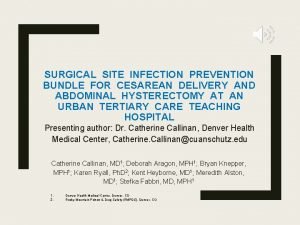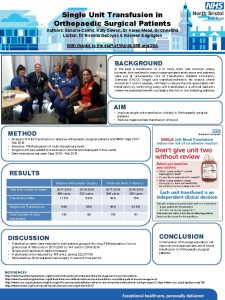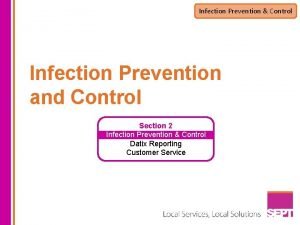Surgical Site Infection Prevention Orthopaedic Joint Surgery Patients










- Slides: 10

Surgical Site Infection Prevention Orthopaedic Joint Surgery Patients Orthopaedic Quality Improvement Committee Dr Steven Rabin Dr Anthony Rinella Paul Gorski Elmer Dulce Mary Vondriska Megan Gerage Victoria Davidson-Bell

Project Aim Statement Evidence based research promotes discontinuation of post-operative antibiotics for total joint patients within 24 hours Ø Baseline results as of September 04 for Orthopaedics was 20% compliance Ø Orthopaedics seeks to discontinue antibiotics within 24 hours of surgery in accordance with antibiotic administration protocol Ø

Project Goals Ø Measurement: l l 100% compliance with antibiotic discontinuation within 24 hours of surgical incision closure 100% Compliance with post-op antibiotic orders: 2 doses of Ancef OR 1 dose of Vancomycin

Action/Solutions Implemented Ø Revised post-op order sets l Fall 04 changes • Ancef 2 doses post-op OR • Vancomycin 1 dose post-op l March 05 • Revised orders to accommodate EPIC order entry Ø Education Program l l Residents 5 South Nurses

National Hospital Quality Measures Orthopedic surgery patients receiving prophylactic antibiotics discontinued within 24 hours after surgery end time UCL = 102. 89 100 80 Percent Mean = 66. 17 60 Post EPIC order revisions Revised Post op orders 40 LCL = 29. 45 ) Se p 05 (n (n =1 5 =1 4 ) ) g 05 Au 5 l-0 Ju 05 (n (n = =1 5 14 ) ) n. Ju -0 5 ay M r-0 5 (n (n = =1 8 12 17 ) Ap M ar -0 5 (n = Fe b- 05 (n n 05 Ja (n = 15 ) ) =1 7 5) (n =1 ec -0 4 D N ov -0 4 (n =1 9) 5) ) -0 4 ct O p 04 (n =1 1 Se Au g 04 (n =1 0 ) ) 15 (n = 4 l-0 Ju n 04 Ju -0 4 ay M (n (n =1 7 =1 8 ) ) ) 12 (n = 4 r-0 Ap ) NP involvement 20 Month Definition: Surgical patients with prophylactic antibiotics discontinued within twenty-four hours after surgery end time / Patients undergoing hip or knee arthroplasty. Data source: LUMC medical records abstracted by RNs. Analysis: Seventy-eight percent of hip or knee arthroplasty patients at LUMC now receive discontinuation of prophylactic antibiotics within 24 hours after surgery end. This improvement followed active involvement by the nurse practitioners in orthopedics.

Joint surgery patients receiving 2 Ancef doses OR 1 Vancomycin dose post-op

Analysis Ø Statistical significant improvement in compliance with discontinuation of antibiotics 24 hours post-op Ø Improvement noted with antibiotic administration protocol compliance. Most recent month at 88%

Current Barriers Ø EPIC program constraints for order entry/medication timing Ø Resident attention to detail of post-op orders for antibiotic timing

Next Steps Continue to: Ø Explore EPIC order entry options- for physicians and nurses Ø Education of physicians and 5 South nurses Ø Ongoing monitoring and sharing of results

Summary Ø Compliance with the UHC Surgical Prevention benchmark goal of antibiotics ending within 24 hours post op rose from 74 in 10/05 to 96 % in 1/06 Ø We are almost at our goal of 100% compliance Ø Antibiotic administration according to protocol continues to require continued monitoring and teaching intervention
 Prevention of vte in nonorthopedic surgical patients
Prevention of vte in nonorthopedic surgical patients Surgical site infection bundle checklist
Surgical site infection bundle checklist Primary prevention secondary prevention tertiary prevention
Primary prevention secondary prevention tertiary prevention Orthopaedic surgery south east london
Orthopaedic surgery south east london Wrong site surgery prevention
Wrong site surgery prevention Acute specific surgical infection
Acute specific surgical infection Puncture resistant container
Puncture resistant container Chapter 19 disease transmission and infection prevention
Chapter 19 disease transmission and infection prevention Chapter 19 disease transmission and infection prevention
Chapter 19 disease transmission and infection prevention Chapter 16 infection control and standard precautions
Chapter 16 infection control and standard precautions Define infection prevention chapter 5
Define infection prevention chapter 5
